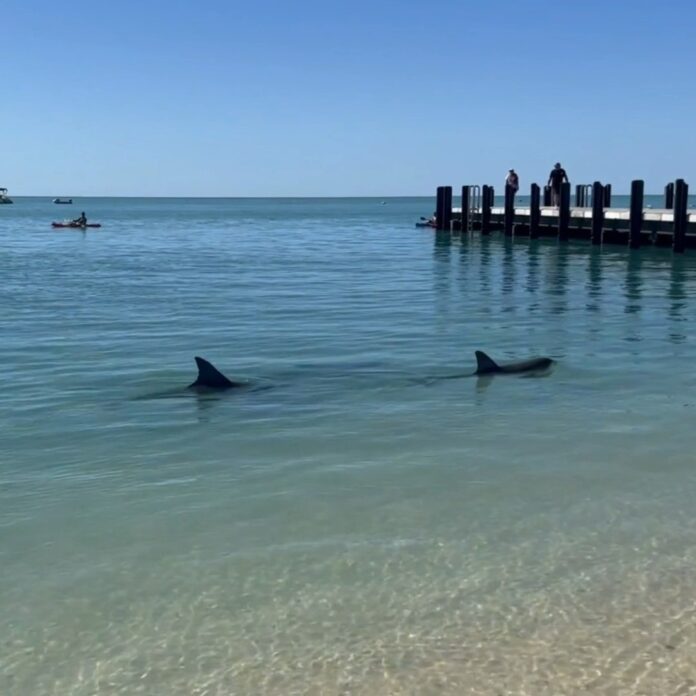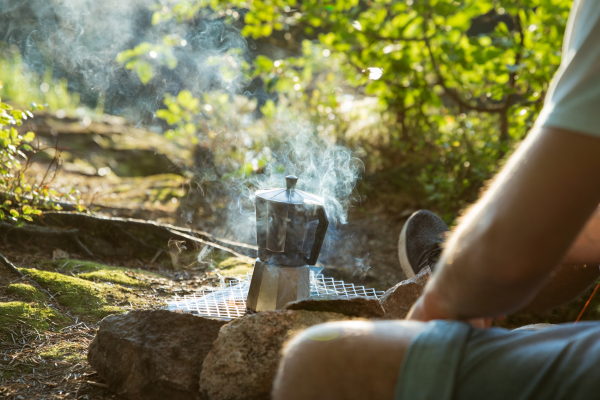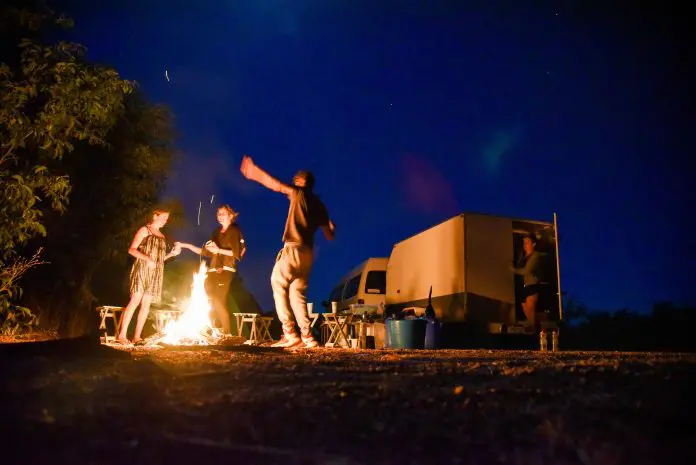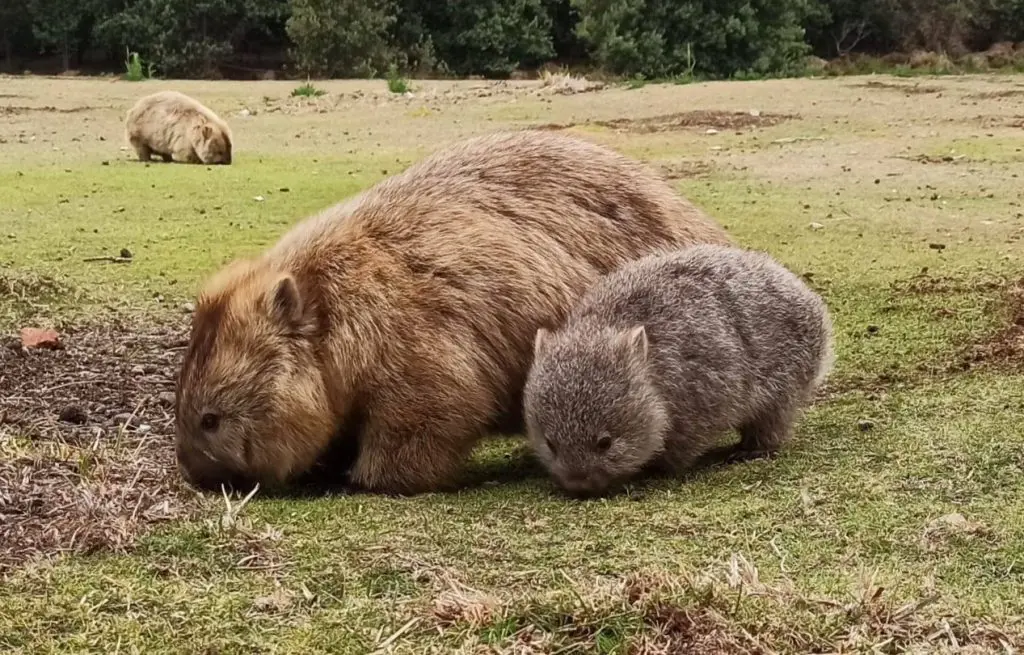
A guide to cute Australian animals and where to find them
With spiders, snakes and jellyfish, when people think about Australian animals they often think about the ‘dangerous ones’. However, it’s nice to remember that Australia also has some incredibly interesting, cute Australian animals that you can’t find anywhere else. As well as the ‘regular’ placental mammals, Australia has marsupials (carry babies in their pouch) and monotremes. Read on to find out about these unique animals and where you can find them.
A guide to cute Australian animals and where to find them
Wombats: one cute Aussie animal
Wombats are adorable. However, they are surprisingly big in real life. They’re about a metre long, and quite solid and muscular. Although cute and cuddly, do not make wombats feel threatened, as they have very powerful claws.

Two cute wombats. Find wombats on Maria Island.
Wombats are the only animals with square-shaped poos. Apparently this is to help them mark their territory, and to stop their poo rolling away. Wombats can be shy. Therefore you can often spot this poo, but never spot the wombat that made it.
They are also marsupials which means they raise their young in pouches like kangaroos.
Where to find wombats:
You can find wombats in Tasmania and on the East Coast in forested mountainous areas. However, below are a couple of places you will definitely see a wombat if you visit.
- Maria Island: A mostly undeveloped island off the east coast of Tasmania. This place has old buildings from convict times which are still mostly intact. Wombats completely cover the island. There is a 100% chance of finding a wombat from the afternoon onwards.
- Kangaroo Valley: This place is about a two-hour drive from Sydney. There is a very nice free camp next to the river here. At night the wombats come out and completely cover the camp.
Wallaby: A cuter Aussie animal than a Kangaroo?
Wallabies look quite similar to Kangaroos. Similarly, they have long tails and raise their young in pouches. However, they are a fair bit smaller. Does this make them a slightly cuter Australian animal than a kangaroo? You tell us.
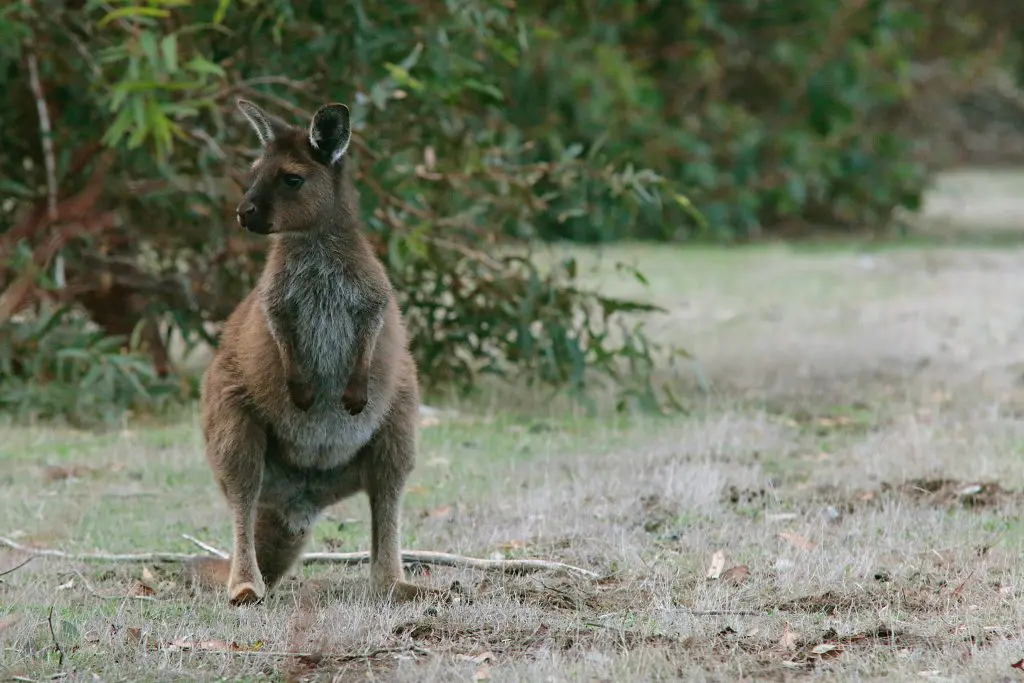
A wallaby. Which is the cuter type of Australian animal: wombats or Kangaroos?
There are many many types of wallabies as the phrase is used to describe different types. For example, some types are rock-wallabies or pademelons, although there are many more.
Where to find wallabies:
You can find wallabies distributed all throughout Australia. Overall, you just need to get out of town and go somewhere remote, or go on a hike. However, I can recommend these places:
- Cape Range National Park: This is the national park near Exmouth, WA on the Ningaloo reef. This place is absolutely beautiful and a crazy amount of wallabies come out at night. You can camp overnight there to spot them (but don’t drive around!)
- Tasmania: If you travel around Tasmania you’ll spot wallabies everywhere. As well as, unfortunately, many as roadkill. I believe this reflects the high population.
Echidnas: curious monotremes
Echidnas are a part of the curious type of mammals called ”monotremes”. These type of mammals lay eggs, yet raise their young by feeding them milk. After the egg hatches, echidnas carry their young in a pouch for the first 3 months of its life. Platypuses are also monotremes like echidnas.

Echidna in the grass
These spiky guys live up to a suprisingly long 16 years in the wild. Echidnas are also well adapted to Australian conditions. During a bushfire, they burrow into the ground, and hibernate until the fire has passed. Fire can burn their quills (the ‘spikes’) without the echidna feeling any pain. Afterwards, the echidna can actually grow back the spikes/quill. However, an echidna that has experienced a fire might rock a funky hair cut for a little while afterwards.
Where to find echidnas:
Echidnas are solitary animals, so they don’t gather in many places where you can spot them. However, if you spend enough time in the right places you’ll definitely spot one.
- Kangaroo Island: This beautiful island in South Australia is reachable by ferry. The port is about 2 hours south of Adelaide. You’re more likely to spot an echidna here in summer, around dusk when the sun starts to set.
- Tasmania: You might be able to spot one at the popular destination, Cradle Mountain. However, in my opinion, you’re probably slightly more likely to spot one trying to cross the road. So keep watch while driving!
Platypus: a weird and shy creature
If a platypus is on your list of animals to spot, you have a ‘difficult quest’ to complete. They are quite shy and will hide when they hear you. However, it’s not impossible to spot one of these cute Australian animals. As long as you are patient and quiet, and are looking for one at the correct time of day you may find one. If not, try again the next day.

A platypus
Platypuses are mysterious creatures. They are monotremes, the type of mammal that lays an egg. In addition to that, They also have a ‘sixth sense’ called electrolocation. This allows them to hunt by detecting the electric field of living things like the worms, larvae and the shrimps it eats. It is also, rarely, a ‘venomous’ mammal. The male has venomous spurs on one of it’s feet. However, don’t worry, a platypus will never let you get close enough to poison you.
Where to find platypuses:
Platypuses live on Tasmania and throughout the east coast. You should search for them when they are more active, at dusk or dawn. Therefore camping close to where they are is a good idea! You will find them at:
- LaTrobe, Tasmania: La Trobe has called themselves the ‘platypus capital’ and there is a boardwalk you can use to try to spot them in the nearby ‘Warrawee Forest Reserve’.
- Eungella National Park, Queensland: If you’re lucky you could spot one here!
Koalas: cute, but have you heard them ‘speak’?
Every visitor knows about the iconic cute Australian animal, the Koala. However, not everyone knows about the not-so-cute sound they make! These cuddly creatures eat eucalyptus leaves. However, these leaves are not very energy-dense. This leads to koalas limiting their energy use by sleeping about 20 hours a day!

A couple of cute koalas
Koala populations are sadly under threat at the moment. A big reason for this is ‘Koala chlamydia’. This causes them to become unable to have babies. Luckily, there a few island populations which have not been affected by this disease. These population might be able to be used as a ‘back up’ population for the future…
Where to find koalas
It’s best to look for koalas in Eastern and coastal regions. You will not be able to find koalas in the natural environment in the Northern Territory or Western Australia.
- Noosa National Park: We heard from some of our travellers that they spotted koalas here on their road trip between Brisbane and Cairns! There is a small active population which people sometimes spot by the park entrance.
- Raymond Island: Somewhere between Melbourne and Sydney close to Lakes entrance. This island is full of animals, free to visit and worth exploring!
Quokka: the happiest Aussie animal?
In recent years, quokkas have received more attention than ever before as people seek out Quokka selfies. Some call them the happiest animal, as they always appear to have a smile on their face. Others think that they are the cutest Australian animal out there!
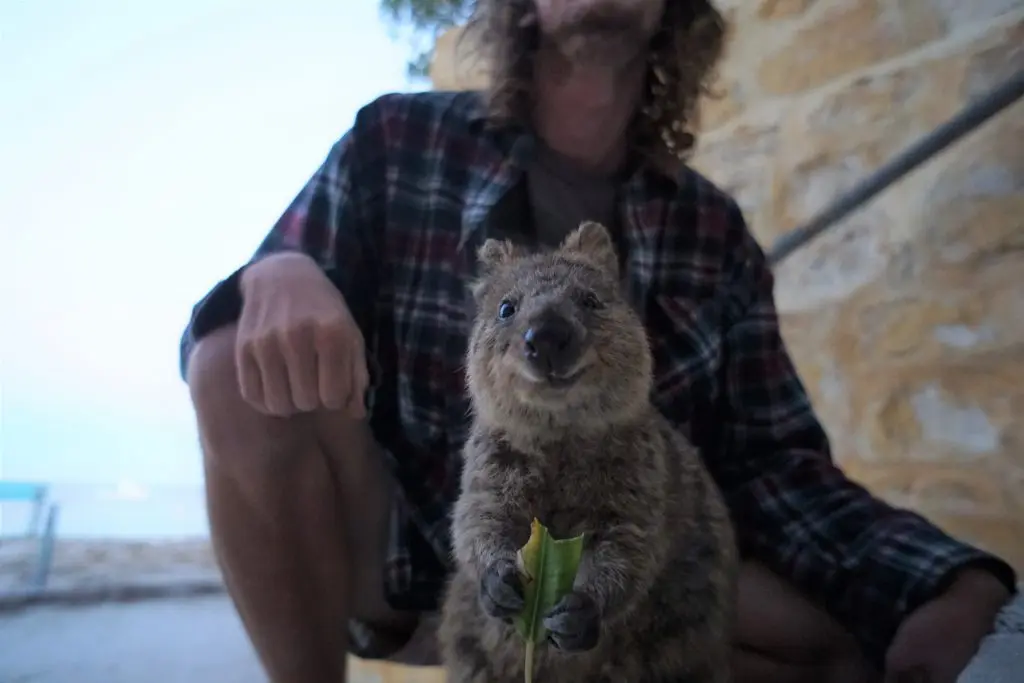
A quokka: They always seem to be smiling
They are easiest to find on Rottnest island, which owes its name to them. In 1696, explorer Vlamingh thought they were giant rats. Because of this, he named the island “Rotte nest”, a word similar to ‘rat nest’ in Dutch. However, they are best described as ‘small wallabies’ rather than ‘large rats’.
Where to find quokkas
Although it is possible to spot them in a few places on mainland Western Australia there are very small populations there. Your best bet is to travel to Rottnest Island, easily accessible from Western Australia’s capital city, Perth.
- Rottnest Island: Best accessed by ferry leaving from Fremantle, a suburb of Perth. The island has no cars so its best to travel around it by bicycle. It’s estimated that about 10,000 quokkas live on Rottnest. Please do not feed the quokkas, salty food can cause them to become dehydrated and ill.
Numbat: An endangered Aussie animal
Sadly there are less than 1500 of this cute little creature left in the wild. These guys are native to Western Australia. These stripy creatures use their very long tongue to eat a diet made exclusively of termites.
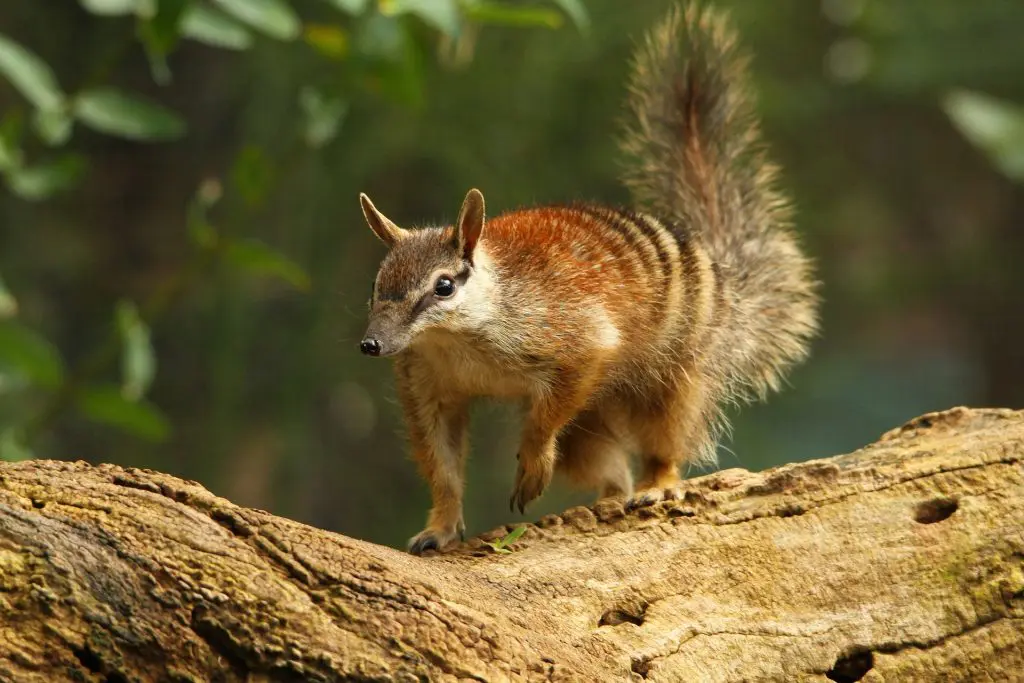
Where to find numbats
Numbat populations have been introduced to a few areas in Australia, however only two natural populations remain. These are at the Dryandra Woodlands near Narrogin, or near Manjimup in Western Australia. Both are in the South-West. Your best chance to spot them would be to volunteer (there doesn’t seem to be public access) at a sanctuary such as Yookamurra Sanctuary, a two-hour drive from Adelaide.
Other Australian Animals?
These strange and wonderful creatures are only a small selection of the cutest Australian animals out there. Who knows… maybe we’ll do another post about the other weird, crazy and cute Australian wildlife out there. What interesting animals have you discovered during your time in Australia?
Check out our trips if you’re interested in jumping on board to spot a few of these creatures.
